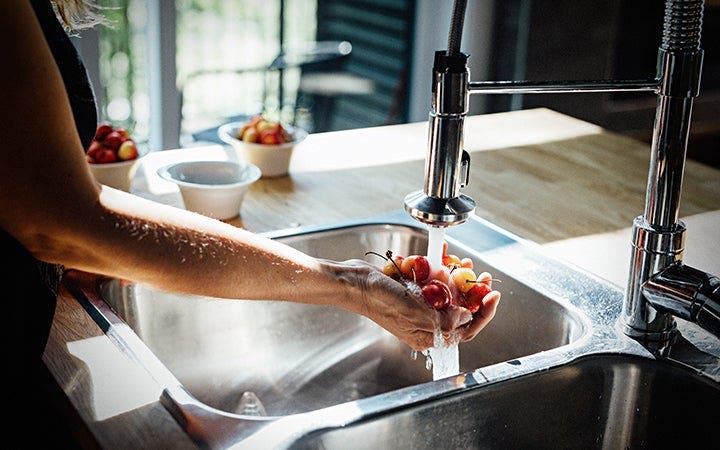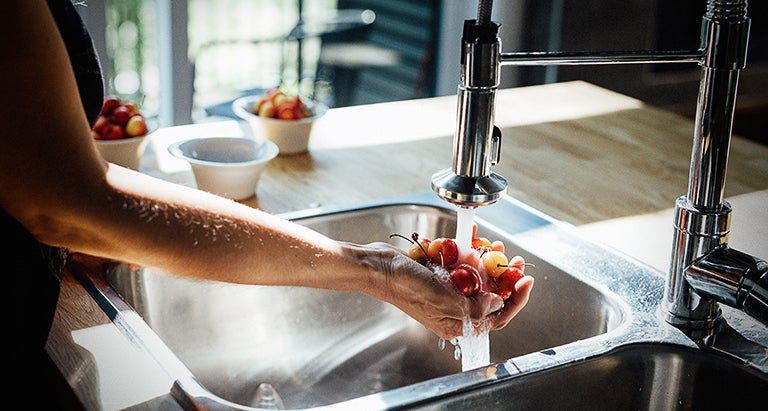FAQs: Goof-Proof Food Safety


Your kitchen is the heart of your home, so it’s likely the high-traffic center, too, full of energy—and distractions and germs. We all know careful food prep, cooking, and cleaning are important. But it’s tough to stay on top of best practices when you’re facing a hungry family, a tight deadline, a new recipe—or all three. Plus, misconceptions are everywhere —5-second rule, anyone?
We gathered 10 common kitchen safety concerns, then turned to nutrition, cleaning, and medical experts for advice. Here's what they said:
1. Is a quick spritz of a household cleaner actually making my counter clean or just spreading the germs around?
When you hear the stats, you’ll probably guess the answer: In a study of 30 items in 22 households conducted by NSF International, countertops in nearly a third of the homes in question harbored coliform bacteria (an indicator of potential fecal contamination). Gross, right? A spritz won’t do it, says Mindy Costello, consumer information specialist for the testing and certifying company. “To get your countertop clean, you need to wash it down with warm, soapy water, then rinse, apply a bleach solution (two tablespoons of bleach per gallon of water) or sanitizer, let it sit for a few minutes, and then wipe it down.”
2. I know you’re not supposed to leave food out, but when I have guests over for a buffet, the dishes may sit for several hours. Do I really have to throw out all those leftovers?
Sorry, but two (hours) is the critical number—food can safely stay in the so-called danger zone (above 40°F) for no more than 120 minutes. If your platters and bowls have been out longer than that, it’s best to toss out even delicious food. How to handle buffets? “You can keep hot foods warm (in a slow cooker, for example) and cold foods cool (on ice),” advises Caroline Passerrello, MS, RDN, LDN, spokesperson for the Academy of Nutrition and Dietetics. “I also put out perishables in small portions, then bring out fresh supplies from the oven or fridge as needed.”
3. Is it really necessary to wash cantaloupe and other fruits with rinds? It's not like I eat that part!
True, but you do cut through the rind, which can introduce anything yucky (like bacteria) onto the part you do eat. There have been several serious outbreaks of foodborne illness traced to contaminated cantaloupes, so to be safe, run the melon under cool tap water, then scrub with a clean produce brush. Don’t use soap.
4. My sister-in-law has separate sponges for dishes and countertops and sink. She’s just an over-the-top germophobe, right?
It actually doesn’t matter whether you use the same sponge or rag to wash your dishes and surfaces, Costello says. What’s important is to sanitize them properly. “For sponges, this means nuking them (wet) in the microwave for two minutes every day or running them through the dishwasher. Rags and dish towels should be laundered with bleach after a day or two of use.”
5. I was always told to put butter on a burn—is that the best way to treat it?
Save the butter for your toast. That folk remedy could delay healing. “For a minor burn—one that’s red, maybe a little painful, but not blistering—run the affected area under cool water for a few minutes, then apply an antibacterial ointment or aloe vera gel,” says Rahul Sharma, MD, emergency physician in chief at New York-Presbyterian/Weill Cornell Medical Center. Don’t use ice or very cold water; chilling can constrict blood vessels or damage your skin. “If it’s a more serious burn, or it’s on your face or eyes, get medical attention promptly from urgent care or an ER.”
6. How do you properly clean a cutting board that had raw meat on it?
First, it’s not just meat you have to be careful with—produce also carries pathogens. If you like to use a wooden board, as opposed to nonporous plastic, it should have a hard, solid surface. Between uses, wash it with hot soapy water, rinse, and apply a bleach/water solution (for this use, the USDA Food Safety and Inspection Service suggests one tablespoon of bleach per gallon of water), then rinse again. Do the same with plastic boards or pop them in the dishwasher. Be diligent. “You’d be better off making a sandwich on your toilet seat than on many cutting boards,” says Charles Gerba, PhD, professor of microbiology at the University of Arizona. “In one study, we found boards with 200 times more fecal contamination than toilets,” he explains.
7. Can my son’s mayonnaise-filled sandwich just sit in his backpack till his lunch hour?
It’s time to give mayonnaise a break: Handled properly, it’s not the kill-you-at-first-bite condiment we’ve long imagined it to be. Actually, if your child’s lunch contains anything perishable—meat, cheese, butter, as well as mayonnaise—and it’s going to be out of refrigeration for more than the magic two hours, it should be in an insulated bag with an ice pack or one of those special, freezable bags, says Passerrello. “You can also freeze a small bottle of water to use as a chill pack,” she suggests. “That way, your child (or spouse) doesn’t have to remember to bring it home.”
8. When I put raw ground turkey in a pan to brown, I stir it with a wooden spoon. Should I use a clean spoon later, after the meat’s cooked, and I’m still stirring?
You should, says Passerrello, because the spoon may have picked up germs that won’t be cooked off once they’re on the utensil. And of course, this applies to any meat that you’re making, not just ground turkey. The same rule holds for instant-read meat thermometers; use them near the end of cooking and wash them off if you’re going to need to take another poke.
9. Why do kitchen cuts take so long to stop bleeding?
You’re probably just impatient to get back to cooking, says Dr. Sharma. To stop the bleeding, you need to apply firm pressure for several minutes (not seconds!); then rinse the cut under running water, dry it, dab on antibiotic ointment, and put on a bandage to keep it clean. If it’s a deep gash or it doesn’t stop bleeding, head to the ER or urgent-care center. One of the biggest reasons for cut fingers, Dr. Sharma adds, is dull knives. “You have to push harder to cut, making it more likely for the knife to slip.”
10. I heard that you can stop cooking turkey while it’s still pink. Is that really OK?
Color is never a good indicator of doneness, says the government’s Food Safety and Inspection Service. The only safe way to test any meat is to cook it until it reaches the proper internal temp on a food thermometer. Check here to find out what that is for the meat you’re making.
4 food-safety precautions you don't have to take
Experts say there's no need to worry about…
- Rinsing triple washed lettuce. You’re more likely to contaminate the greens, which can pick up germs from your sink. Also, in the extremely unlikely event that your produce does carry bacteria or other microbes, rinsing won’t eliminate them.
- Washing raw chicken. Again, it’s a question of cross-contamination— in this case, you’re likely to spread any “chicken germs” to your sink and counters. And cooking your poultry will take care of those bugs.
- Prewashing dishes before you put them in the dishwasher. Most of today’s dishwashers use special soil-sensing technologies to “tell” how dirty the load is, explains Jill Notini, vice president, communications and marketing, of the Association of Home Appliance Manufacturers. “If you’ve already rinsed the dishes, the machine won’t put out as much force. Do, however, scrape off large bits of food,” Notini recommends.
- Roasting pork until it’s totally dry. At one time, experts advised cooking pork roasts and chops to 160°F. Today, because of spiffed-up industry standards for raising pigs and new government tests, the safe temperature is 145°F, followed by three minutes of rest. (Stick with 160°F for ground pork.)
